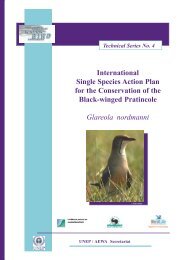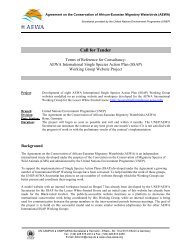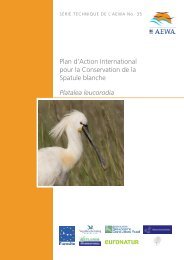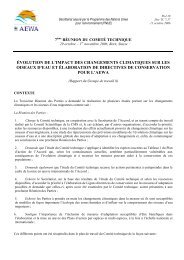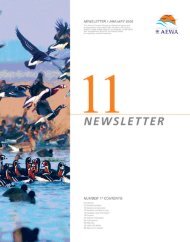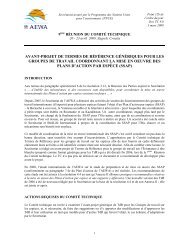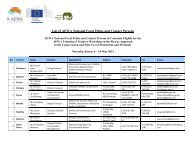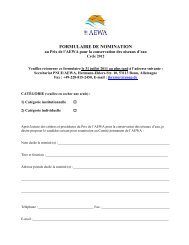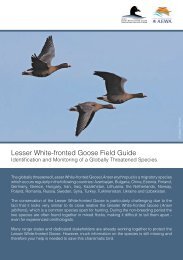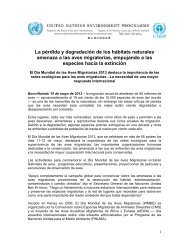International Single Species Action Plan for the ... - AEWA
International Single Species Action Plan for the ... - AEWA
International Single Species Action Plan for the ... - AEWA
You also want an ePaper? Increase the reach of your titles
YUMPU automatically turns print PDFs into web optimized ePapers that Google loves.
<strong>AEWA</strong> Technical Series No. 36<br />
Known staging areas <strong>for</strong> birds from <strong>the</strong> Western main population include: parts of <strong>the</strong> Ob<br />
river valley (<strong>the</strong> “Double Ob area”, Russia); <strong>the</strong> lakes and agricultural land of Kustanay<br />
Oblast, north-west Kazakhstan, where Lake Kulykol is of particular importance (Tolvanen &<br />
Pynnönen 1998; Tolvanen et al. 2001, Yerokhov et al. 2000); <strong>the</strong> Sultan-Aksuat lakes system<br />
in <strong>the</strong> western part of neighbouring Nor<strong>the</strong>rn-Kazakhstan Oblast, (Yerokhov et al. 2005); and<br />
<strong>the</strong> Shalkar lakes on <strong>the</strong> border of <strong>the</strong> Orenburg area (Russia) and Aqtobe province<br />
(Kazakstan) (http://www.piskulka.net/Satellite%20tracking.htm). The main wintering areas<br />
are unknown but thought to be around <strong>the</strong> nor<strong>the</strong>rn Black Sea coast, <strong>the</strong> sou<strong>the</strong>rn Caspian<br />
Sea, inland wetlands of Azerbaijan, and <strong>the</strong> inland wetlands of Iran and Iraq, especially <strong>the</strong><br />
Mesopotamian Marshes. During <strong>the</strong> winter of 2004/2005, satellite tracking of one individual<br />
ringed and satellite-tagged in <strong>the</strong> Polar Urals region, nor<strong>the</strong>rn Russia, in August 2004, has<br />
confirmed that at least some birds continue to winter in Iraq (Morozov & Aarvak 2004, Øien<br />
& Aarvak 2005; http://www.piskulka.net/Satellite%20tracking.htm). More recently still,<br />
satellite tracking of individuals ringed on <strong>the</strong> Putorana Plateau of Russia in July and August<br />
2006 migrated south-west across <strong>the</strong> West Siberian depression, to staging areas in<br />
Kazakhstan. Subsequently two birds were tracked to <strong>the</strong> westen shore of <strong>the</strong> Caspian Sea to<br />
<strong>the</strong> border area between Iran and Azerbaijan, one bird later reaching Iraq<br />
(http://www.piskulka.net/Satellite%20tracking.htm). An expedition located at least eight<br />
Lesser White-fronts in eastern Syria (close to <strong>the</strong> border with Iraq) in February 2007, while<br />
over 50 were reported at a second site later in <strong>the</strong> month<br />
(http://www.piskulka.net/Recent%20observations.htm). Limited winter count data are<br />
available <strong>for</strong> sites in Uzbekistan that <strong>for</strong>merly held significant numbers of wintering Lesser<br />
White-fronts.<br />
Small numbers of vagrant Lesser White-fronted Geese occur regularly in Germany scattered<br />
among flocks of Greater White-fronts. There are indications that at least some of <strong>the</strong>se birds<br />
may belong to <strong>the</strong> Western main population (Mooij & Heinicke in prep.), while satellite<br />
tracking in <strong>the</strong> 1990s showed that a bird from <strong>the</strong> Fennoscandian population have occurred in<br />
East Germany.<br />
Supplemented/Reintroduced population<br />
As described above, a human-modified flyway has now been established between <strong>the</strong> release<br />
area <strong>for</strong> captive-bred birds in Swedish Lapland and The Ne<strong>the</strong>rlands, crossing north-west<br />
Germany. There are sporadic records from o<strong>the</strong>r countries, often of individual birds mixing<br />
with flocks of o<strong>the</strong>r goose species, mostly Barnacle Geese. All released individuals have been<br />
colour-ringed, but as <strong>the</strong>re have been no releases since 1999 and because <strong>the</strong> offspring of<br />
released birds are not ringed, <strong>the</strong> proportion of colour ringed birds in <strong>the</strong> population has<br />
gradually declined. Never<strong>the</strong>less, colour-ringing has enabled a relatively comprehensive<br />
picture of <strong>the</strong>ir movements to be established.<br />
Summary by Principal Range State<br />
Lesser White-fronted Geese occur regularly in at least 20 States within <strong>the</strong> European Union<br />
and/or <strong>AEWA</strong> Agreement Area (Table 1). These are referred to as ‘Principal Range States’ in<br />
<strong>the</strong> remainder of <strong>the</strong> <strong>Action</strong> <strong>Plan</strong> and have <strong>the</strong> major responsibility <strong>for</strong> its implementation. A<br />
country is listed as a Principal Range State where one or more Important Bird Area (IBA) <strong>for</strong><br />
Lesser White-fronted Goose has been identified within its territory. IBAs have <strong>the</strong>mselves<br />
been identified on <strong>the</strong> basis of internationally accepted criteria published by BirdLife<br />
<strong>International</strong>. In <strong>the</strong> case of countries where IBAs have not been <strong>for</strong>mally identified, it is<br />
suggested that a Principal Range State EITHER holds one or more sites where at least 15<br />
staging/wintering individuals are recorded regularly (e.g. Uzbekistan) OR where a<br />
combination of historical counts and recent satellite data provide strong evidence of <strong>the</strong><br />
country’s importance (e.g. Iraq, Syria, Azerbaijan, Lithuania). Lesser White-fronted Geese<br />
occur as vagrants or irregular visitors in many o<strong>the</strong>r countries. For fur<strong>the</strong>r details, see Chapter<br />
2 and Annex 2.<br />
<strong>International</strong> <strong>Single</strong> <strong>Species</strong> <strong>Action</strong> <strong>Plan</strong> <strong>for</strong> <strong>the</strong> Conservation of <strong>the</strong> Lesser White-fronted Goose 17



